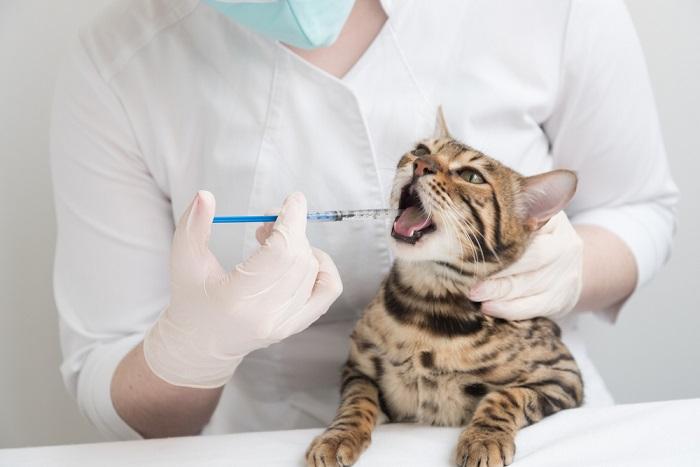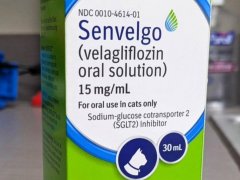
Pyrantel is a very common dewormer used primarily against roundworms and hookworms in cats. Common brand names for pyrantel include Strongid and Nemex. In this article, you’ll learn how pyrantel works, when it is most commonly used in veterinary medicine, common side effects to watch for, and some frequently asked questions.
Pyrantel for Cats Overview

About Pyrantel for Cats
Pyrantel pamoate is a pyrimidine anthelmintic (dewormer) used primarily for ascarids. Ascarids are roundworms of different types that cause disease known as ascariasis. They include actual roundworms (Toxocara cati) as well as hookworms (Ancylostoma tubaeforme, Ancylostoma braziliense), which are technically also a kind of very tiny roundworm.
Although pyrantel is typically very effective at deworming for cat roundworms, it otherwise has a very limited range of effect. Pyrantel is not considered a very broad-spectrum dewormer as it cannot target other parasites seen in cats, like whipworms, coccidia, Giardia, Toxoplasma, etc.
Pyrantel also has very limited effects on the rest of the body because it is poorly absorbed through the GI tract. This makes it ideal for the gastrointestinal parasites it treats, but not for any other types of parasites or diseases.
What Does Pyrantel Do for Cats

Cats get hookworms when they ingest hookworm larvae, typically when walking on a contaminated surface. Cats may pick up hookworms through their skin or during grooming.
Pyrantel is most commonly used as a dewormer when roundworms or hookworms are found in a cat’s stool/fecal sample. It is also common to use in young kittens as an empirical dewormer for roundworms, typically about every two to three weeks until a kitten is at least 12 weeks old.
Pyrantel can be used against the cat roundworm Toxocara cati, but is also effective against the roundworm Toxascaris leonina, which may less commonly affect cats and also affects dogs.
Its efficacy against hookworms include the cat hookworms Ancylostoma tubaeforme and Ancylostoma braziliense, as well as the dog hookworms Ancylostoma caninum and Uncinaria stenocephala, which may also less commonly affect cats.
Another dewormer that treats for both roundworms and hookworms that veterinarians may use off-label in cats is fenbendazole. If you have general questions about dewormers and the types of parasites they treat, you can find additional information here.
Side Effects of Pyrantel for Cats

Adverse reactions to pyrantel are uncommon; some cats might have stomach upset when the worms die off.
Fortunately, pyrantel is very well tolerated in cats and adverse reactions are very uncommon. Cats with heavier burdens of roundworms or hookworms may experience vomiting, diarrhea, abdominal pain, or a poor appetite after being given pyrantel. These side effects are usually more related to the death and expulsion of affected parasites and not the medication itself.
Because pyrantel is poorly absorbed from the gastrointestinal tract and acts more locally on parasites present in the intestine, systemic effects on the body are very rare.
Adverse effects are more possible if appropriate doses are not given. Doses of up to seven times the appropriate dose still generally do not result in signs of toxicity.
In severe overdose situations, signs including an increased respiratory rate, profuse sweating (in cats this may just be visible from the bottoms of the feet) and trouble walking (ataxia) may be seen.
Drug interactions with pyrantel are uncommon and it is safe to use with a majority of other commonly used drugs. Pyrantel should not be used with a couple of other dewormers including levamisole, morantel, and piperazine. Organophosphates, a common class of household insecticide, can already cause toxicities in pets, but effects can be worse when interacting with pyrantel.
If you are ever concerned that your kitty may have developed side effects while using pyrantel, or if an overdose is suspected, make sure to contact your veterinarian, the ASPCA Animal Poison Control Center (1-888-426-4435), or Pet Poison Helpline (1-855-764-7661) immediately for further advice.
Pyrantel for Cats Dosage

Pyrantel is usually used in liquid form and given by mouth.
As a single agent, pyrantel is most commonly used in its liquid form, as this makes it the easiest to dose accurately, especially for very young and growing kittens.
While pyrantel is FDA approved in dogs, it is not in cats. However, it is considered just as safe and appropriate to use in cats as it is in dogs.
Pyrantel in many forms can be purchased over the counter. For the 50 milligram/milliliter liquid, a common rule of thumb is to dose at 1 milliliter per 10 pound of body weight. Essentially, taking the body weight in pounds and dividing by 10 will give you the dose in milliliters. A 2-pound pound kitten for example, would get 0.2 milliliters.
This rule of thumb dose equates closely to a dose of 10 milligram/kilogram. This is the most common dose used for kittens. Kittens can be dosed as early as 2 to 3 weeks of age and should be given a dose every two to three weeks until they are at least 12 weeks old.
Stool samples may not always represent a full picture of parasite burden, especially if they only include egg counts. Veterinarians often recommend deworming through 12 weeks of age, even if a stool sample at 8 weeks shows no parasite eggs. Newer PCR (DNA) based stool samples, which don’t rely on egg-shedding alone, may indicate deworming can be stopped earlier.
In adult cats, higher doses of 20 milligram/kilogram are more often recommended. While a single dose may be effective, I usually recommend a second dose about three weeks later or rechecking with a PCR-based stool sample test.
Pyrantel tablets can also be used, but need to be broken up to provide the correct dose.
Pyrantel does also come in a variety of products that combine it with other deworming drugs. An example includes Drontal (pyrantel combined with praziquantel), which is FDA approved for use in cats and kittens at least 8 weeks of age and weighing more than 2 pounds.
While most pyrantel and pyrantel combination products are considered over the counter, some sources, especially online pharmacies, may require a prescription from a veterinarian.
Conclusion
Pyrantel is a very commonly used dewormer that addresses roundworm and hookworm infections in cats and kittens. It has a high margin of safety and is very inexpensive on its own, but is limited in terms of the types of parasites it can address.
Drug Dosing Disclaimer: We are only able to provide doses for medications that are FDA approved for use in cats and only as the label guidelines dictate. For medications that are used off-label we can only provide guidelines and safety information for use. Safe and appropriate dosing for off-label medications can only be determined by a primary care veterinarian.
We encourage you to work with your veterinarian to determine if a particular medication is appropriate for your cat. Changing or adjusting a dose for your cat on your own without consulting with a veterinarian can carry risk. We do not encourage use of medications prescribed for human use in pets without first consulting with a primary care veterinarian.
Frequently Asked Questions
How much pyrantel can I give my cat?
The dose can range anywhere from 5 milligrams/kilogram for kittens up to 20 milligrams/kilogram for adult cats. The rule of thumb of 1 milliliter per 10 pounds of body weight approximates closely with a 10 milligram/kgkilogram dose. In kittens, deworming should be repeated every two to three weeks until 12 weeks of age. In adult cats, at least two doses three weeks apart should be sufficient to end a roundworm infection.
Recheck fecal samples are very important, especially after treating an adult cat for roundworms or hookworms, to gauge if treatment has been successful.
With any medication, even one that can be obtained over the counter, it’s important to discuss accurate dosing amount and frequency with a veterinarian.
How long does It take for pyrantel to work in cats?
Because pyrantel is not absorbed very much from the GI tract and instead remains active in the lower GI tract of cats, the same kind of pharmacokinetic (drug absorption, metabolization, and excretion) information available for other drugs is not available for pyrantel.
However, when locally acting against GI parasites, efficacy against existing worms typically occurs within a few hours.
While pyrantel may kill adult worms quickly, repeat doses are needed especially in kittens due to intermittent egg shedding cycles, and because hatched roundworm larvae migrate over several weeks through other tissues before returning to the GI tract. A single dose alone may miss any of these larvae that return to the GI tract as adults a few weeks later.
How do you give pyrantel to a cat?
Pyrantel is most commonly given as a liquid medication orally through a dosing syringe. This allows for the greatest accuracy in volume, especially for very young kittens. Mixing pyrantel with milk or canned food for groups of cats or kittens should be avoided, as some cats may get more drug than is necessary while others may be underdosed.
Pyrantel tablets may also be used. The tablets are FDA approved for dogs, but can be used in cats if they are broken down into smaller pieces to achieve the proper dose.
Is pyrantel dewormer safe for cats?
Pyrantel is extremely safe to use in cats when dosed appropriately. Although as a single agent it is not FDA approved for cats, the combination product Drontal (combined with praziquantel) is. The single-agent liquid or tablets FDA approved for dogs may also be used very safely in cats however. The margin of safety for pyrantel is very high with at least a seven times therapeutic dose not showing signs of toxicity.








I need to know how much to give to a 12# cat
Hi Pamela, the dosing information is in the article. It is roughly 1.0ml per 10lb of body weight. For a 12lb cat, that would be 1.2ml. For roundworms/hookworms, usually 2 doses about 3 weeks apart.
Thank you so much for the ml dose. It is difficult for me to figure mg’s into ml’s. I am happy to have found your post.